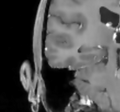Documentation/4.5/Modules/AnomalousFilters
|
For the latest Slicer documentation, visit the read-the-docs. |
Introduction and Acknowledgements
|
This work was partially funded by CAPES, a Brazillina Finantial Agency. Information on CAPES can be obtained from the CAPES website. | |||||||
|
Module Description
Anomalous diffusion processes (ADP) are mathematically denoted by a power law in the Fokker-Planck equation, leading to the generalized form. There are several generalizations of the Fokker-Plank equation, which should give many different partial differential equations (PDEs). Here we adopt only the so-called porous media form, allowing the super-diffusive and the subdiffusive processes. [1] In porous media, channels are created promoting or blocking the flow of the density function, which has been proved to provide a suitable application on MRI filtering.[2]
Basically, there are two different filters already implementing the anomalous diffusion process: the isotropic anomalous diffusion and anisotropic anomalous diffusion filters.[3] Each of these filters were already applied on different imaging MR modalities, such as structural T1 and T2 images[4], diffusion weighted images (DWI and DTI)[5][6], MRI relaxation T1 and T2 relaxometry[7] and in fMRI[8] as an initial study.
Use Cases
Most frequently used for these scenarios:
- Use Case 1: Noise reduction as a preprocessing step for tissue segmentation
- When dealing with single voxel classification schemes running noise reduction as a preprocessing scheme will reduce the number of single misclassified voxels.
- Use Case 2: Preprocessing to volume rendering
- Noise reduction will result in nicer looking volume renderings
- Use Case 3: Noise reduction as part of image processing pipeline
- Could offer a better segmentation and classification on specific brain image analysis such as in Multiple Sclerosis lesion segmentation
Tutorials
- Sample scenes:
- Usage:
- Load the downloaded .mrb scene file into Slicer
- Go to the Sequence browser module to browse the data set
Panels
{{documentation/4.5/module-parametersde
Similar Modules
References
Information for Developers
| Section under construction. |
Definitions:
- Sequence: Contains an ordered array of data nodes, each data node is tagged with an index value.
- Data node: A regular MRML node, one item in the sequence. Data nodes are stored privately inside the sequence, therefore not visible in the main scene (where the sequence node is in). Singleton nodes are not allowed to be stored as data nodes. Sequence nodes can be data nodes, therefore sequence of sequence nodes can be used to represent higher-dimensional data sets.
- Sequence index: The index describes the dimension of the data node sequence. The index name (such as "time"), unit (such as "s"), and type (such as "numeric" or "text") is the same for the whole sequence. The index value is specified for each data node. The index type information is used for sorting (numerical or string sorting) and matching of the index values (in case of a numerical index we can find the closest data node even if there is no perfectly matching index value).
- Sequence browsing: A sequence node only contains the data nodes, but does not store any node relationships, such as parent transform, display properties, etc. These relationships can be only defined for the virtual output nodes that are generated by the Sequence browser module. Several browser nodes can be created to visualize data from the same sequence, which allows visualization, comparison of multiple different time points from the same sequence.
- Virtual output node: The sequence browser node creates a copy of the selected privately stored data node in the main scene. This copy is the virtual output node.
Repositories:
- Source code: GitHub repository
- Issue tracker: open issues and enhancement requests
- ↑ Tsallis, C. (2009). Introduction to Nonextensive Statistical Mechanics: Approaching a Complex World. Springer.
- ↑ Da S Senra Filho, A. C., Garrido Salmon, C. E., & Murta Junior, L. O. (2015). Anomalous diffusion process applied to magnetic resonance image enhancement. Physics in Medicine and Biology, 60(6), 2355–2373. doi:10.1088/0031-9155/60/6/2355
- ↑ Da S Senra Filho, A. C., Garrido Salmon, C. E., & Murta Junior, L. O. (2015). Anomalous diffusion process applied to magnetic resonance image enhancement. Physics in Medicine and Biology, 60(6), 2355–2373. doi:10.1088/0031-9155/60/6/2355
- ↑ Da S Senra Filho, A. C., Garrido Salmon, C. E., & Murta Junior, L. O. (2015). Anomalous diffusion process applied to magnetic resonance image enhancement. Physics in Medicine and Biology, 60(6), 2355–2373. doi:10.1088/0031-9155/60/6/2355
- ↑ Senra Filho, A. C. da S., Duque, J. J., & Murta, L. O. (2013). Isotropic anomalous filtering in Diffusion-Weighted Magnetic Resonance Imaging. Conference Proceedings: Annual International Conference of the IEEE Engineering in Medicine and Biology Society. IEEE Engineering in Medicine and Biology Society. Conference, 2013, 4022–5. doi:10.1109/EMBC.2013.6610427
- ↑ Senra Filho, A. C. da S., Simozo, F. H., Salmon, C. E. G., & Murta Junior, L. O. (2014). Anisotropic anomalous filter as a tool for decreasing patient exam time in diffusion-weighted MRI protocols. In XXIV Brazilian Congress on Biomedical Engineering (pp. 0–3). Uberlandia.
- ↑ Filho, A. C. da S. S., Barbosa, J. H. O., Salmon, C. E. G. S., & Junior, L. O. M. (2014). Anisotropic Anomalous Diffusion Filtering Applied to Relaxation Time Estimation in Magnetic Resonance Imaging. In Annual International Conference of the IEEE Engineering in Medicine and Biology Society (pp. 3893–3896). IEEE. doi:10.1109/EMBC.2014.6944474
- ↑ Filho, A. C. da S. S., Rondinoni, C., Santos, A. C. dos, & Junior, L. O. M. (2014). Brain Activation Inhomogeneity Highlighted by the Isotropic Anomalous Diffusion Filter. In Annual International Conference of the IEEE Engineering in Medicine and Biology Society (pp. 3313–3316). Chicago: IEEE. doi:10.1109/EMBC.2014.6944331







